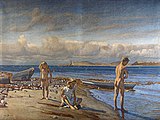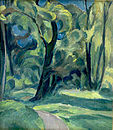
Faaborg or Fåborg is an old port town located on Faaborg Fjord in Faaborg-Midtfyn municipality on the island of Funen in Denmark. By road, Faaborg is located 42 kilometres (26 mi) southwest of Odense, 27 kilometres (17 mi) west-northwest of Svendborg, and roughly 70 kilometres (43 mi) southeast of Middelfart, depending upon the route. It has a population of 6,944. With its busy port, narrow streets and attractive old houses, the town is popular with tourists, particularly in the summer months. Faaborg was formerly the seat of Faaborg municipality. The seat of the new municipality is Ringe. Both municipalities use(d) Faaborg's medieval coat of arms.

Kerteminde, is a town in central Denmark, located in Kerteminde Municipality on the island of Funen. The town has a population of 6,042. It is a small harbor town surrounded by farms. Kerteminde contains a fish restaurant, Rudolf Mathis, the Viking museum Ladby, and the research and exhibition institution for fish and porpoises Fjord & Bælt.
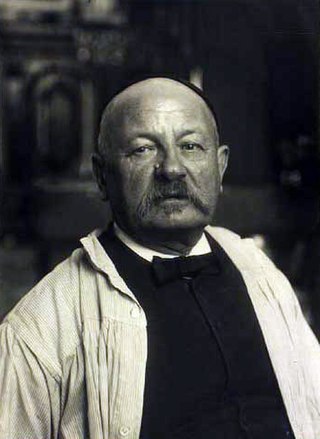
Peder Henrik Kristian Zahrtmann, known as Kristian Zahrtmann, was a Danish painter. He was a part of the Danish artistic generation in the late 19th century, along with Peder Severin Krøyer and Theodor Esbern Philipsen, who broke away from both the strictures of traditional Academicism and the heritage of the Golden Age of Danish Painting, in favor of naturalism and realism.

Johannes Larsen was a Danish nature painter.

Danish art is the visual arts produced in Denmark or by Danish artists. It goes back thousands of years with significant artifacts from the 2nd millennium BC, such as the Trundholm sun chariot. For many early periods, it is usually considered as part of the wider Nordic art of Scandinavia. Art from what is today Denmark forms part of the art of the Nordic Bronze Age, and then Norse and Viking art. Danish medieval painting is almost entirely known from church frescos such as those from the 16th-century artist known as the Elmelunde Master.

Harald Giersing was a Danish painter. He was instrumental in developing the classic modernism movement in Denmark around 1910-1920. He is remembered as one of Denmark's most important 20th-century artists both for his portraits and landscapes.
Grønningen is a Danish artists cooperative whose members arrange exhibitions and similar events. Founded in 1915, it is one of the oldest and most important groupings of its kind in Denmark and currently has 54 members. It is named after the street Grønningen in Copenhagen where the first art exhibition was held.

Kunstnernes Frie Studieskoler was an art school established in Copenhagen in 1882 as a protest against the policies of the Royal Danish Academy of Fine Arts and to provide an alternative to its educational program. It existed until 1912 and was a central institution of the Modern Breakthrough in Danish art.

Peter Marius Hansen was a Danish painter who became one of the Fynboerne or "Funen Painters" group living and working on the island of Funen.
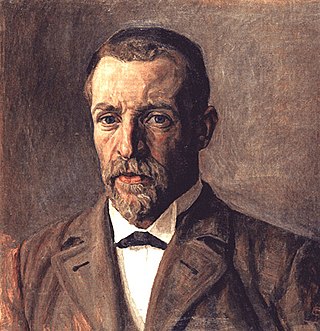
Christian Friedrich Wilhelm Heinrich Syberg, generally known as Fritz Syberg, was a Danish painter and illustrator, one of the or Funen Painters (Fynboerne) living and working on the island of Funen.

Anna Louise Birgitte Syberg was a Danish painter. Together with her husband Fritz Syberg, she was one of the Funen Painters (Fynboerne) who lived and worked on the island of Funen. She is remembered for her lively watercolours of flower arrangements.
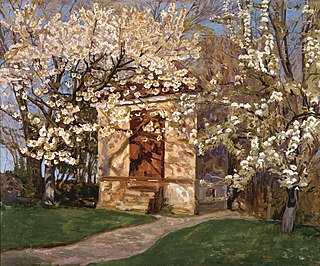
Alhed Maria Larsen née Warberg, the wife of Johannes Larsen, was one of the Fynboerne or "Funen Artists" who lived and worked on the Danish island of Funen. She appears to have been a central figure for the Funen Painters, frequently acting as hostess.
Harald Leth was a Danish painter whose Naturalistic work was inspired by Johannes Larsen of the Funen Painters and Oluf Høst of the Bornholm School.
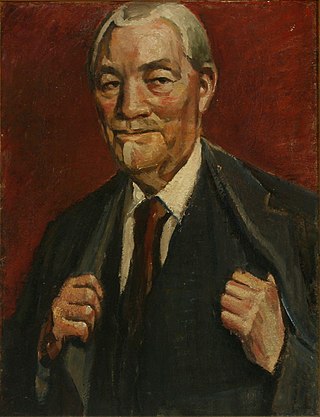
Poul Simon Christiansen, frequently referred to as Poul S. Christiansen was a Danish painter who developed a Colourist style under Kristian Zahrtmann and as a result of his appreciation of the works of Paul Gauguin and Vincent van Gogh. He painted landscapes and religious works, many of which became popular as reproductions.
Christine Swane née Christine Larsen was a Danish painter who first associated with the Funen Painters before developing her own increasingly Cubist style.
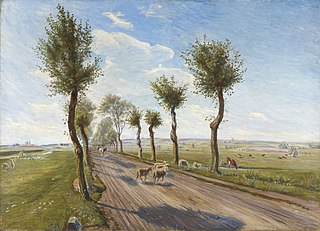
Odsherred Painters is a term applied to Danish artists from various periods with connections to Odsherred in the northwest of Zealand, Denmark. Some were born there while others settled in the area or painted there. While the term includes painters from the 19th century such as Johan Thomas Lundbye, Vilhelm Kyhn and Vilhelm Melbye, it is applied more specifically to the painters who created landscapes from 1930 to 1970 and who formed an artists' colony. They include Karl Bovin, Kaj Ejstrup, Viggo Rørup, Ellen Krause, Lauritz Hartz, Povl Christensen, Victor Brockdorff and Sigurd Swane.
Ernst Axel Syberg was a Danish painter who in the early 1930s associated with the artists' colony in northwestern Zealand known as the Odsherred Painters. From 1934, he was a member of Corner where he exhibited his work.

Jens Birkholm was a Danish genre painter associated with the group known as the Funen Painters.

Syberg Keramik was a Danish ceramics manufacturer based in the Valby district of Copenhagen, Denmark. It was created by Hans Syberg and later taken over by his brother Lars Syberg,. It existed from 1928 until the 1980s and was based in Valby





